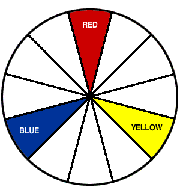
Probably the first lesson you ever learned about color
was that red, blue, and yellow are the primary colors. Every
other color is made up of some combination of these three.
When selecting carpet, you may not choose the bright
boldness of a pure primary color. But certain versions of
the primary colors, like maroon, navy, or gold, can be the
perfect choice for your home.